Tin Solder Market Size
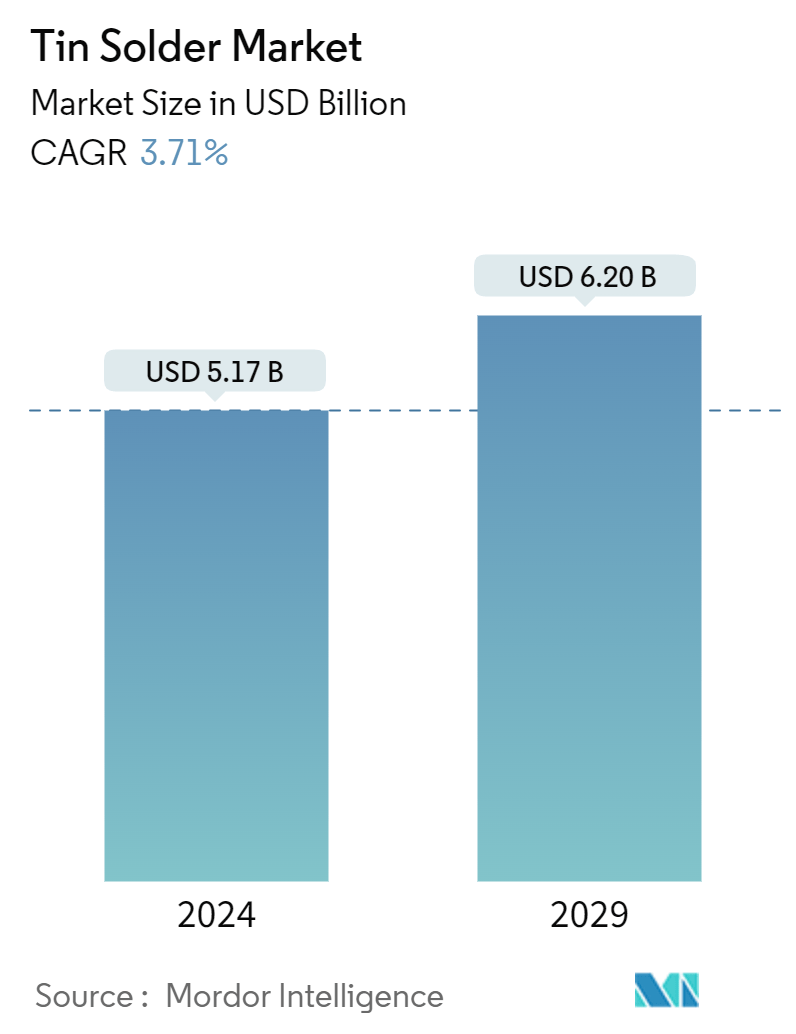
| Study Period | 2019 - 2029 |
| Market Size (2024) | USD 5.17 Billion |
| Market Size (2029) | USD 6.20 Billion |
| CAGR (2024 - 2029) | 3.71 % |
| Fastest Growing Market | Asia Pacific |
| Largest Market | Asia Pacific |
Major Players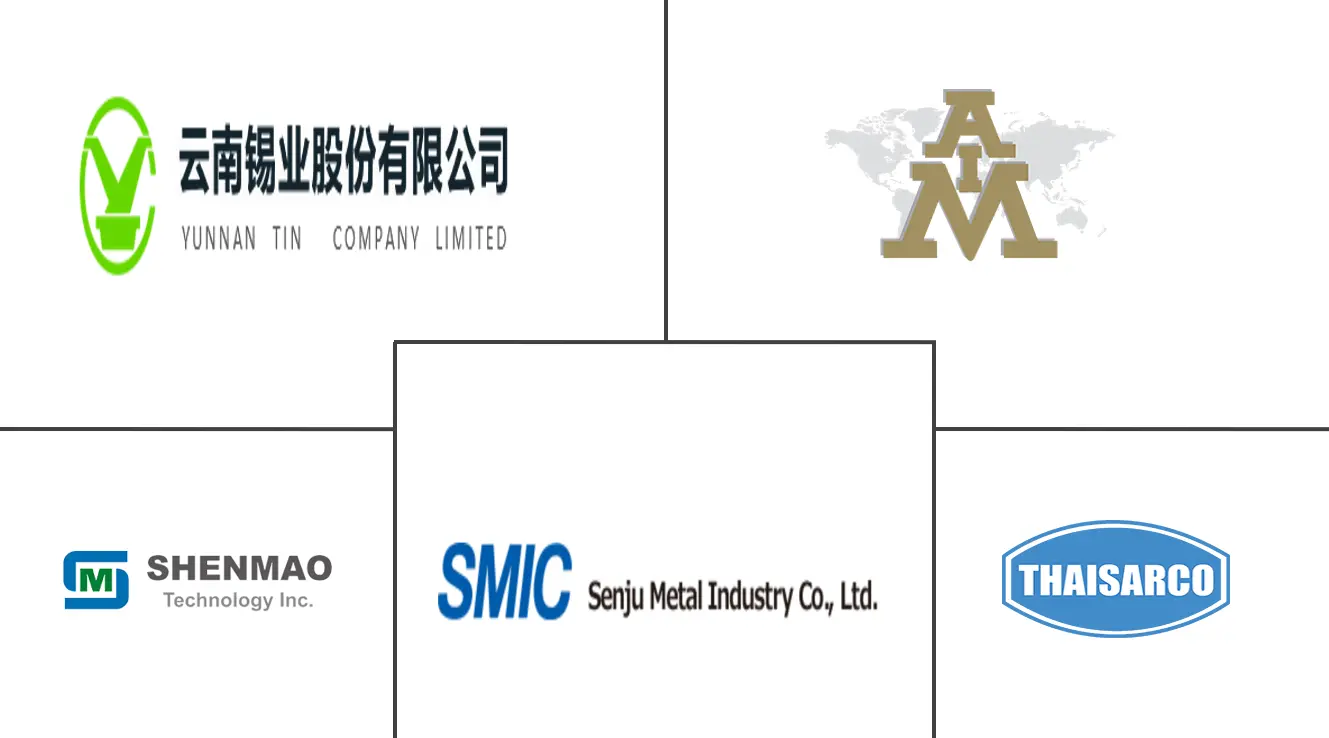
*Disclaimer: Major Players sorted in no particular order |
Tin Solder Market Analysis
The Tin Solder Market size is estimated at USD 5.17 billion in 2024, and is expected to reach USD 6.20 billion by 2029, growing at a CAGR of 3.71% during the forecast period (2024-2029).
Due to the COVID-19 outbreak, nationwide lockdowns worldwide, disruption in manufacturing activities and supply chains, and production halts negatively impacted the market in 2020. However, the conditions started recovering in 2021, thereby restoring the growth trajectory of the market.
• Over the short term, the increasing demand from the electronics industry and rising automotive production are expected to propel the market's growth.
• On the flip side, the regulatory restrictions on the usage of lead-based tin solder and the availability of substitutes are expected to hinder the market's growth.
• The emergence of nanoparticle-based solder materials and an increase in investments in solar photovoltaic energy are expected to create growth opportunities for the market studied.
• The Asia-Pacific region is expected to dominate the market and is also the fastest-growing region.
Tin Solder Market Trends
Electronics Segment is Expected to Dominate the Market
- Tin solder plays a critical role in electronics by forming a strong mechanical and conductive connection between electrical components and circuit boards. This allows for the secure attachment of delicate components while ensuring a smooth flow of electricity through the soldered joints. The melting point of tin solder is low enough to avoid damaging heat-sensitive electronic parts during the soldering process.
- Tin-lead wire solder is prevalent in electronics, especially where components are prone to melting, cracking, or warping at high temperatures. It offers good electrical properties and enhances mechanical strength.
- The increasing usage and expanding application scope in the electronics industry are expected to drive the global market for tin solders. The electronics solder is one of the world’s largest and fastest-growing industries. In today’s digital era, electronic devices continue to profoundly impact and shape our lives.
- According to the Japan Electronics and Information Technology Industries Association (JEITA), global electronics production decreased by around 2.5% in 2023, reaching JPY 10,699,267 million (~USD 73,218.96 million) compared to the previous year. However, ongoing efforts to digitally transform society, businesses, and industries and address social issues through innovations like generative AI are expected to drive demand for solution services and rebound the demand for electronic components. In 2024, digitization and the adoption of innovative technologies are poised to accelerate the growth of the global electronics sector, with an anticipated 9% increase to USD 3,690 billion compared to 2023.
- According to the German Electrical and Electronic Manufacturers Association (ZVEI), the global electronics market reached EUR 169.50 billion (~USD 181.87 billion) in 2023. The expanding production of electronics worldwide is forecasted to have a positive impact on the market in the coming years.
- Germany stands out as Europe's electronics powerhouse. The country's electrical and electronics sector, as reported by the Germany Electrical and Electronics Association, dominates Europe and ranks among the world’s top five largest markets, boasting a turnover of EUR 238 billion (~USD 262.66 billion) in 2023. The robust electronics market in Germany is likely to increase the consumption of tin solder, which is essential for producing high-quality electronic devices.
- The electronics manufacturing sector in India has been another major consumer of tin solder in recent times. The country is expected to see a rise in demand for various electronic goods in future years. According to Pankaj Mohindroo, Chairman of the Indian Cellular and Electronics Association, the total production of electronics goods in the financial year 2023-2024 is estimated to reach USD 115 billion.
- Tin solder plays a pivotal role in connecting electrical components and semiconductors to circuit boards. These circuit boards are integral to a wide array of everyday consumer technologies, from phones and TVs to computers, cameras, washing machines, and refrigerators.
- In August 2024, the US Department of Commerce unveiled a USD 1.6 billion investment to bolster Texas Instruments' semiconductor production. Once operational, TI's Sherman facilities are set to produce over 100 million chips daily.
- In July 2024, the Canadian government, through ISED (Innovation, Science and Economic Development Canada), announced to invest USD 120 million in the FABrIC (Fabrication of Integrated Components for the Internet’s Edge) network. This five-year initiative, exceeding USD 220 million, aims to bolster Canada's semiconductor manufacturing and commercialization capabilities.
- Hence, the above-mentioned factors are expected to impact the demand for tin solder in the electronics industry during the forecasted period.
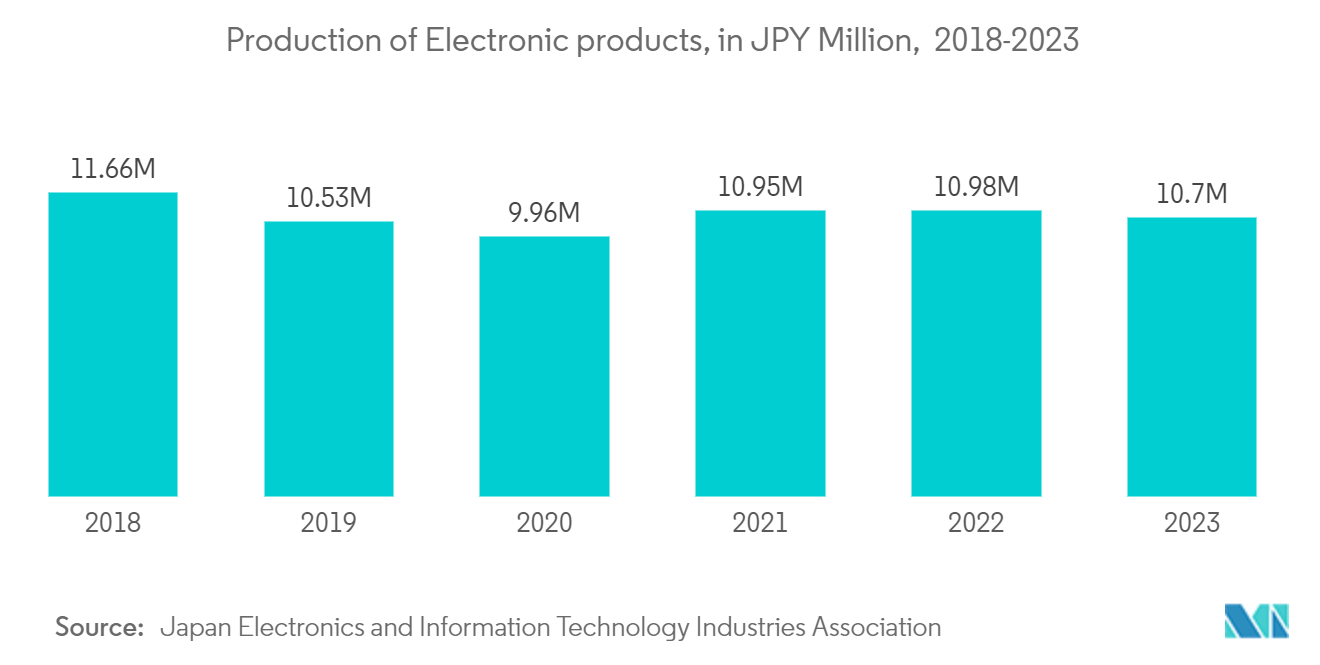
Asia-Pacific Region is Expected to Dominate the Market
- In the Asia-Pacific region, automotive production has seen a growing demand, which had a positive impact on the tin solder market.
- The Asia-Oceania region emerged as the frontrunner in vehicle manufacturing, outpacing other regions. OICA data highlights that automotive production in this region reached 55.11 million units in 2023, up by 10.18% from 2022's 50.02 million units. Notably, this production is largely spearheaded by key players like China, Japan, South Korea, and India.
- According to the China Association of Automobile Manufacturers (CAAM), China has the most significant automotive production base in the world. In 2022, the total vehicle production was 27 million units, an increase of 3.4 % compared to 26 million units produced last year.
- According to the latest data released by the China Association of Automobile Manufacturers (CAAM), car production in the country exceeded 30.16 million units in 2023, registering an 11.6% increase compared to the previous year. A total of 30.09 million units of passenger cars were sold in the country in 2023, registering a nearly 12% increase compared to the previous year.
- According to the data released by the Society of India Automotive Manufacturing (SIAM), 4.58 million automotive vehicles were manufactured in the financial year 2023, compared to 3.65 million vehicles produced in the financial year 2022. The country saw a rise of around 25% in automotive production in 2023 compared to the previous year.
- Tin solder is also used in various other applications, including aerospace and defense, solar, plumbing, roofing, and glass. Soldering in the aerospace and defense industry is a meticulous process that upholds the highest standards of cleanliness, safety, and quality.
- China is a major player in the global aerospace market, excelling in aircraft manufacturing and domestic air travel. The country's aircraft parts and assembly sector is growing rapidly, with over 200 small parts manufacturers. According to the International Trade Administration (ITA), China is the second-largest civil aerospace market globally. As of January 2024, the National Bureau of Statistics of China and the Civil Aviation Administration of China reported 7,351 civil aircraft, an increase of over 550 airplanes from 2022.
- The South Korean Defense Acquisition Program Administration (DAPA) plans to work on light aircraft with an investment of EUR 1.8 billion (USD 1.94 billion), which is expected to be operable in 2033. Hyundai Heavy Industries is involved in this manufacturing process, which requires annual maintenance of EUR 180 million (USD 194.16 million).
- Malaysia is one of the major manufacturers of various electronic products, such as semiconductors, industrial electronics, telecommunications, and consumer electronics. In order to increase the manufacturing of various electronic goods in the country, various manufacturers have started to invest in the country’s electrical and electronics industry. In 2023, a total of USD 18.12 billion worth of investments were approved by the government for the manufacturing of electrical and electronic products in the country.
- All the above-mentioned factors are expected to have a positive impact on the tin solder market in the Asia-Pacific region during the forecast period.
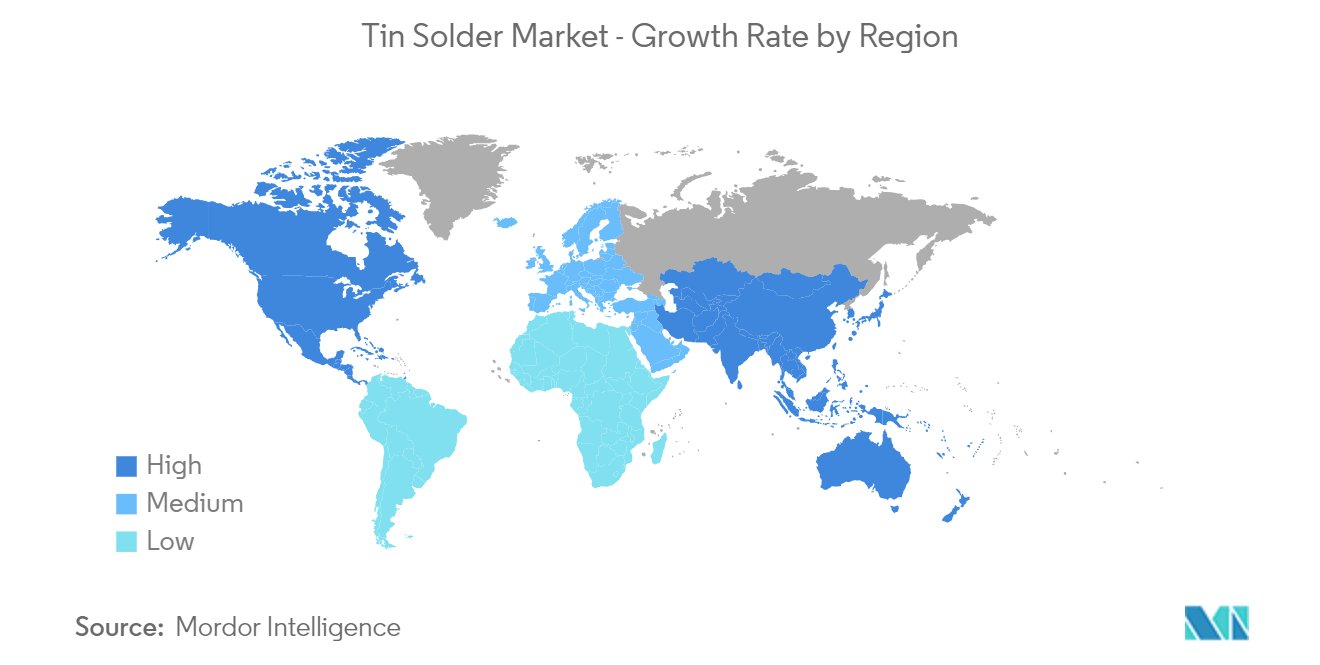
Tin Solder Industry Overview
The tin solder market is fragmented in nature. The major players (not in any particular order) include Yunnan Tin Company, AIM Metals & Alloys LP, SHENMAO Technology Inc., Senju Metal Industry Co. Ltd, and Thailand Smelting and Refining Co. Ltd.
Tin Solder Market Leaders
-
Yunnan Tin Company
-
AIM Metals & Alloys LP
-
SHENMAO Technology Inc
-
Senju Metal Industry Co. Ltd
-
Thailand Smelting and Refining Co. Ltd
*Disclaimer: Major Players sorted in no particular order
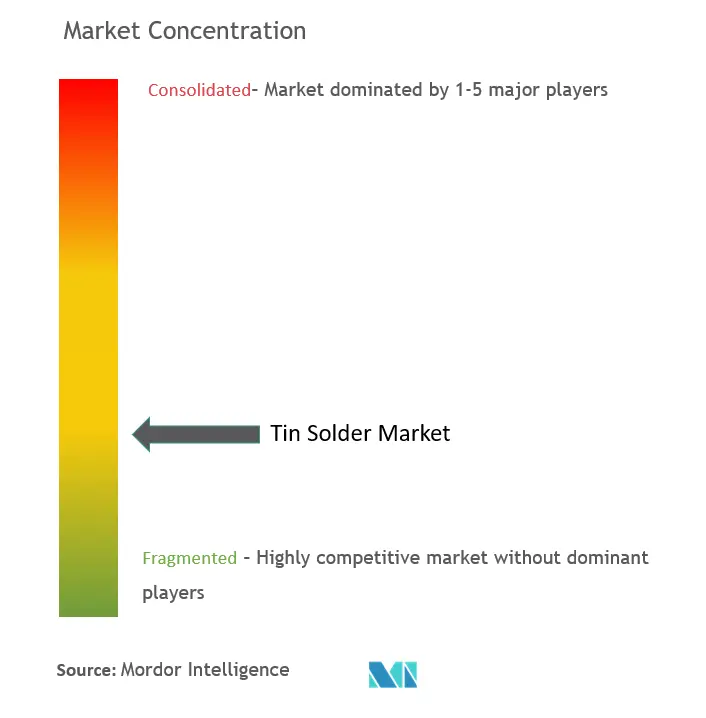
Tin Solder Market News
- June 2024: SHENMAO Technology Inc. launched a new thermal fatigue-resistant solder paste, PF918-P250. This paste can meet high-reliability requirements and offers advanced features and superior performance for electronic products requiring exceptional durability.
- October 2023: AIM Solder (UK) Ltd acquired William Rowland Limited’s solder products business, encompassing solders and alloys. Through this acquisition, the company would expand its capabilities and enhance customer offerings in the metal industry.
- September 2023: Stannol GmbH & Co. KG launched its new SP6000 solder paste in Munich. This solder paste has been developed as a standard for use with the alloys TSC305 (Sn96.5Ag3Cu0.5) T4 and TSC105 (Sn98.5Ag1Cu0.5) T4. Compared to conventional solder pastes, it can save more than 85% of CO2 emissions.
Tin Solder Market Report - Table of Contents
1. INTRODUCTION
- 1.1 Study Assumptions
- 1.2 Scope of the Study
2. RESEARCH METHODOLOGY
3. EXECUTIVE SUMMARY
4. MARKET DYNAMICS
- 4.1 Introduction
-
4.2 Market Dynamics
- 4.2.1 Drivers
- 4.2.1.1 The Increasing Demand from Electronics Industry
- 4.2.1.2 Rising Automotive Production
- 4.2.2 Restraints
- 4.2.2.1 Regulatory Restrictions on Lead-based Tin Solder
- 4.2.2.2 Availability of Substitutes
- 4.3 Industry Value Chain Analysis
-
4.4 Porter's Five Forces Analysis
- 4.4.1 Bargaining Power of Suppliers
- 4.4.2 Bargaining Power of Buyers
- 4.4.3 Threat of New Entrants
- 4.4.4 Threat of Substitute Products and Services
- 4.4.5 Degree of Competition
5. MARKET SEGMENTATION (Market Size in Value)
-
5.1 Type
- 5.1.1 Solder Wire
- 5.1.2 Solder Bar
- 5.1.3 Solder Paste
- 5.1.4 Other Types
-
5.2 Alloy Type
- 5.2.1 Leas Based Tin Solder
- 5.2.2 Lead Free Tin Solder
-
5.3 Application
- 5.3.1 Electronics
- 5.3.2 Automotive
- 5.3.3 Other Applications
-
5.4 Geography
- 5.4.1 Asia-Pacific
- 5.4.1.1 China
- 5.4.1.2 India
- 5.4.1.3 Japan
- 5.4.1.4 South Korea
- 5.4.1.5 Malaysia
- 5.4.1.6 Thailand
- 5.4.1.7 Indonesia
- 5.4.1.8 Vietnam
- 5.4.1.9 Rest of Asia-Pacific
- 5.4.2 North America
- 5.4.2.1 United States
- 5.4.2.2 Canada
- 5.4.2.3 Mexico
- 5.4.3 Europe
- 5.4.3.1 Germany
- 5.4.3.2 United Kingdom
- 5.4.3.3 Italy
- 5.4.3.4 France
- 5.4.3.5 Spain
- 5.4.3.6 NORDIC countries
- 5.4.3.7 Turkey
- 5.4.3.8 Russia
- 5.4.3.9 Rest of Europe
- 5.4.4 South America
- 5.4.4.1 Brazil
- 5.4.4.2 Argentina
- 5.4.4.3 Rest of South America
- 5.4.5 Middle East and Africa
- 5.4.5.1 Saudi Arabia
- 5.4.5.2 South Africa
- 5.4.5.3 Rest of Middle East and Africa
6. COMPETITIVE LANDSCAPE
- 6.1 Mergers, Acquisitions, Joint Ventures, Collaborations, and Agreements
- 6.2 Market Ranking Analysis
- 6.3 Strategies Adopted by Leading Players
-
6.4 Company Profiles
- 6.4.1 AIM Metals & Alloys LP
- 6.4.2 Element Solutions Inc.
- 6.4.3 Harima Chemicals Group Inc.
- 6.4.4 Indium Corporation
- 6.4.5 KOKI Company Ltd
- 6.4.6 Nihon Genma
- 6.4.7 Senju Metal Industry Co. Ltd
- 6.4.8 SHENMAO Technology Inc.
- 6.4.9 Shenzhen Jufeng Solder Co. Ltd
- 6.4.10 Stannol Gmbh & Co. KG
- 6.4.11 Thailand Smelting and Refining Co. Ltd (Thaisarco)
- 6.4.12 Yunnan Tin Company
- *List Not Exhaustive
7. MARKET OPPORTUNITIES AND FUTURE TRENDS
- 7.1 Emergence of Nanoparticle-based Solder Materials
- 7.2 Rising Investments in Solar Photovoltaic Energy
Tin Solder Industry Segmentation
Tin solder, an alloy predominantly made of tin, is used to forge lasting electrical and mechanical bonds between metals. Historically, lead was a common additive, but due to rising environmental and health concerns, lead-free alternatives have gained prominence. Currently, tin solder is widely utilized in sectors like electronics manufacturing and the automotive industry.
The tin solder market is segmented by type, alloy type, application, and geography. By type, the market is segmented into solder wire, solder bar, solder paste, and other types. By alloy type, the market is segmented into lead-based tin solder and lead-free tin solder. By application, the market is segmented into electronics, automotive, and other applications. The report also covers the market size and forecasts for the tin solder market in 22 countries across major regions. For each segment, the market sizing and forecasts were made based on value (USD).
| Type | Solder Wire | |
| Solder Bar | ||
| Solder Paste | ||
| Other Types | ||
| Alloy Type | Leas Based Tin Solder | |
| Lead Free Tin Solder | ||
| Application | Electronics | |
| Automotive | ||
| Other Applications | ||
| Geography | Asia-Pacific | China |
| India | ||
| Japan | ||
| South Korea | ||
| Malaysia | ||
| Thailand | ||
| Indonesia | ||
| Vietnam | ||
| Rest of Asia-Pacific | ||
| Geography | North America | United States |
| Canada | ||
| Mexico | ||
| Geography | Europe | Germany |
| United Kingdom | ||
| Italy | ||
| France | ||
| Spain | ||
| NORDIC countries | ||
| Turkey | ||
| Russia | ||
| Rest of Europe | ||
| Geography | South America | Brazil |
| Argentina | ||
| Rest of South America | ||
| Geography | Middle East and Africa | Saudi Arabia |
| South Africa | ||
| Rest of Middle East and Africa |
Tin Solder Market Research FAQs
How big is the Tin Solder Market?
The Tin Solder Market size is expected to reach USD 5.17 billion in 2024 and grow at a CAGR of 3.71% to reach USD 6.20 billion by 2029.
What is the current Tin Solder Market size?
In 2024, the Tin Solder Market size is expected to reach USD 5.17 billion.
Who are the key players in Tin Solder Market?
Yunnan Tin Company, AIM Metals & Alloys LP, SHENMAO Technology Inc, Senju Metal Industry Co. Ltd and Thailand Smelting and Refining Co. Ltd are the major companies operating in the Tin Solder Market.
Which is the fastest growing region in Tin Solder Market?
Asia Pacific is estimated to grow at the highest CAGR over the forecast period (2024-2029).
Which region has the biggest share in Tin Solder Market?
In 2024, the Asia Pacific accounts for the largest market share in Tin Solder Market.
What years does this Tin Solder Market cover, and what was the market size in 2023?
In 2023, the Tin Solder Market size was estimated at USD 4.98 billion. The report covers the Tin Solder Market historical market size for years: 2019, 2020, 2021, 2022 and 2023. The report also forecasts the Tin Solder Market size for years: 2024, 2025, 2026, 2027, 2028 and 2029.
Tin Solder Industry Report
Statistics for the 2024 Tin Solder market share, size and revenue growth rate, created by Mordor Intelligence™ Industry Reports. Tin Solder analysis includes a market forecast outlook for 2024 to 2029 and historical overview. Get a sample of this industry analysis as a free report PDF download.



